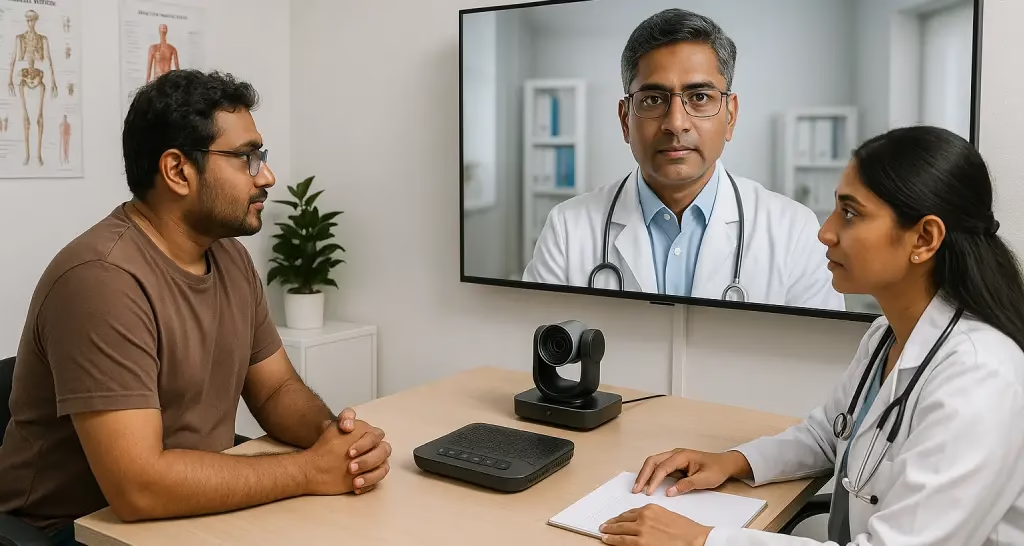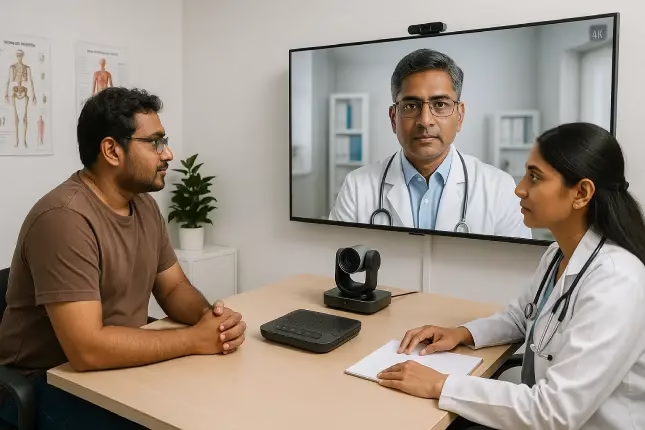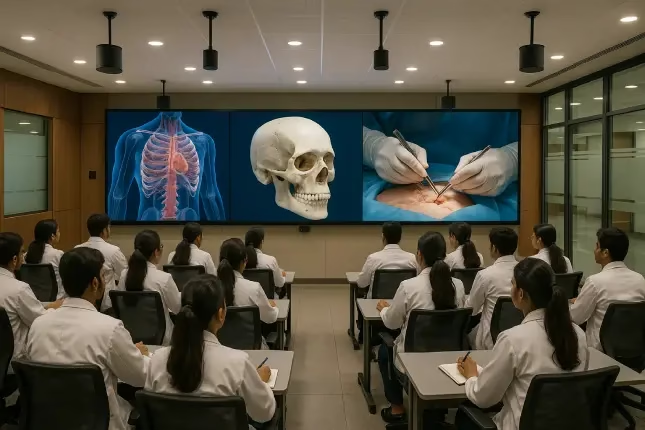
5 Powerful Ways AV Integration in Healthcare Improves Patient Care
Why AV Integration in Healthcare Matters Today
AV Integration in Healthcare has become a vital component of modern medical infrastructure, enhancing how hospitals communicate, deliver care, and train their staff. From hybrid learning environments in medical colleges to real-time monitoring systems in intensive care units, integrated audio-visual solutions are transforming healthcare into a more connected and patient-focused ecosystem. Whether in education, diagnostics, or day-to-day operations, AV integration is driving measurable improvements in both outcomes and experiences across healthcare facilities
Recent research shows how digital health tools are expanding access and improving care delivery worldwide (Medicon, 2025). In India, a case study on the national telemedicine platform eSanjeevaniOPD highlights how it has scaled consultations across the country, marking AV Integration in Healthcare as a core enabler of smarter hospitals (ResearchGate, 2021).
5 Key Benefits of AV Integration in Healthcare Facilities
1. Better Patient Care and Experience
AV integration in healthcare facilities enhances the overall patient journey through:
- Interactive digital signage that helps patients and visitors navigate complex hospital layouts with ease.
- Waiting area displays that share health education, real-time updates, and calming or engaging content.
- Bedside entertainment systems that offer comfort through entertainment and access to relevant medical or recovery-related information.
- Patient communication interfaces that allow patients to call for assistance, adjust room settings, or access services digitally.
- Enhanced privacy and security with AV-controlled room access and monitoring systems.
2. Smarter Medical Training and Education
AV tools support ongoing medical education by offering:
- Recorded sessions enable medical students to revisit practical demonstrations and theoretical content, reinforcing their understanding outside the classroom.
- Virtual reality (VR) and augmented reality (AR) simulations that allow for hands-on practice in risk-free environments.
- Interactive whiteboards and smart classrooms make theoretical topics more engaging and collaborative.
- Hybrid learning platforms that support both in-person and remote education for medical staff and students.
- Live-streaming capabilities for surgeries or specialist-led sessions that enhance real-time learning experiences.
3. Stronger Communication and Collaboration
In healthcare, clarity saves lives. AV integration ensures staff stay connected:
- AV-equipped meeting rooms allow departments to coordinate treatment plans.
- Video conferencing connects local doctors to international specialists for second opinions.
- Hospital-wide PA systems deliver urgent announcements in seconds.
4. Operational Efficiency and Cost Savings
AV isn’t just about care; it improves how hospitals run.
- Centralized dashboards reduce manual coordination and errors.
- Remote consultations save travel costs for both doctors and patients.
- Energy-efficient AV systems improve the sustainability of the environment and lower utility expenses.
Better Effective Medical Simulation & Training
Textbooks and chalkboards are no longer the only tools used in medical education. With AV-enabled classrooms:
- Lecture capture systems allow students to review complex procedures anytime.
- VR/AR-based simulations give budding doctors hands-on practice without risk.
- Interactive displays make anatomy classes or surgical demonstrations far more engaging.
This kind of AV integration in healthcare ensures the next generation of doctors is trained with real-world precision.
AV Integration in Healthcare and Telemedicine
The idea of telemedicine is no longer futuristic; it is here, widely used, and thrives on AV integration. The pandemic accelerated its adoption, but even today, hospitals and clinics continue to rely on AV technology to deliver care beyond physical walls.
How AV Powers Telemedicine
- High-quality cameras and microphones allow doctors to conduct virtual consultations that feel almost face-to-face. A cardiologist in Delhi can examine a patient in a remote village without traveling.
- Cloud-based AV platforms ensure medical records, imaging scans, and live consultations are securely stored and accessed from anywhere. This is particularly crucial for rural and underserved communities where specialists are scarce.
- Hybrid consultations let patients and families seek second opinions without long travel times or costs, making care more affordable and accessible.
Real-World Impact
- In India, the national telehealth service has transformed doctor-patient access. A PMC Study highlights how digital platforms like e-consultations are reshaping care delivery, especially in regions where hospitals are far apart.
- According to recent market projections, India’s telehealth sector is expected to grow from USD 6.3 billion in 2024 to over USD 27 billion by 2030, reflecting a compound annual growth rate (CAGR) of approximately 27.7%. (Source:grandviewresearch.com)
AV Integration in Telemedicine
Telemedicine today goes beyond simple video calls, enabled by advanced AV integration:
Remote diagnostics
Doctors can connect live with on-site nurses who use AV-synced medical devices, enabling accurate diagnosis from a distance.
Virtual rehabilitation sessions
Physiotherapists guide patients through exercises remotely using high-quality AV platforms, ensuring proper technique and continuous support.
Cross-border medical collaboration
Specialists from different countries can review patient scans, lab reports, and treatment plans in real time via secure AV conferencing tools.


Why It Matters
Telemedicine backed by strong AV systems is not just a convenience; it’s a lifeline. For rural India, it reduces the urban–rural healthcare gap. For global healthcare, it brings expertise where it’s needed most, instantly. Additionally, it results in less travel, cheaper expenses, and faster access to care for patients.
Real-World Use Cases of AV Integration in Healthcare
Vallect has already delivered advanced AV solutions in the healthcare sector. For instance, our AIIMS Bathinda project shows how smart classrooms and auditorium AV systems support both medical education and patient engagement.
Hospitals and Clinics
- Operating theaters with AV integration allow surgeons to broadcast live procedures for training.
- Patient monitoring systems ensure real-time data visualization.
- Digital signage reduces confusion in multi-specialty hospitals.
Medical Institutes and Universities
- Hybrid classrooms support both in-person and remote learners.
- Recorded sessions help students revise critical lessons before exams.
- Simulation labs powered by AV prepare students for high-pressure scenarios.
Corporate Hospitals
- AV-equipped boardrooms allow hospital administrators to make data-driven decisions.
- Telepresence systems connect global healthcare leaders.
- Patient experience is enhanced with touchscreens and wayfinding kiosks.
FAQs: AV Integration in Healthcare
Q1. What is AV Integration in Healthcare?
AV Integration in Healthcare means combining audio-visual solutions like CCTV, displays, conferencing tools, and digital signage into one connected system for hospitals and institutes.
Q2. How does AV integration improve patient care?
It improves patient navigation, reduces stress with clear communication, and enables entertainment and education systems for a better experience.
Q3. What AV solutions are used in hospitals?
Common systems include digital signage, video conferencing, lecture capture, CCTV, PA systems, and hybrid classrooms.
Q4. Can AV integration support telemedicine in rural areas?
Yes, it’s a core enabler of telehealth platforms like India’s eSanjeevani, which has reached millions of patients.
Q5. What are the costs of AV integration in healthcare?
Costs vary by hospital size and requirements, but ROI is seen in efficiency, patient satisfaction, and reduced operational friction.
Conclusion: Making Healthcare Smarter with AV Integration
At its core, AV Integration in Healthcare isn’t about flashy technology. It’s about building safer hospitals, smarter classrooms, and more connected systems that support doctors, patients, and medical staff alike.
If you’re planning to upgrade your healthcare facility, now is the time to act. Because the hospitals of tomorrow will be built on the AV foundations you lay today.
Want to explore AV solutions for your hospital or institute? Contact us at info@vallect.com or +91-730343533.
